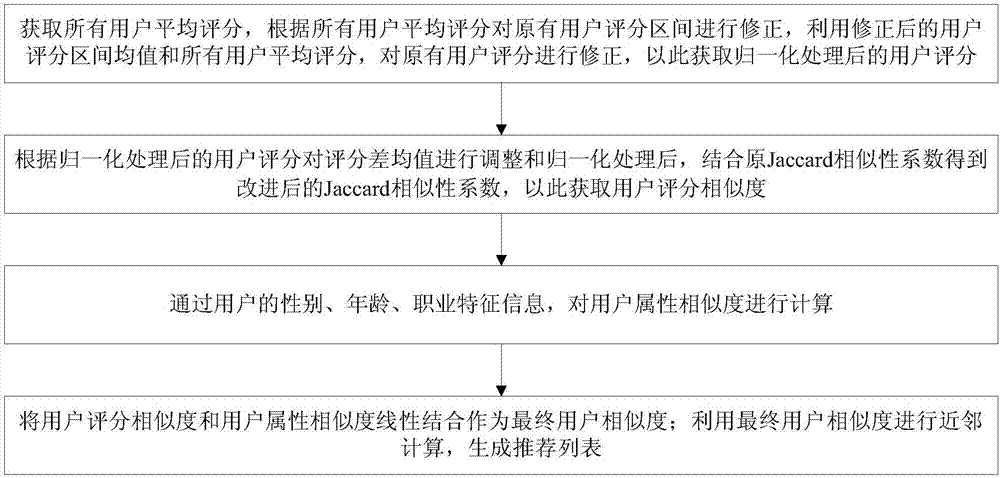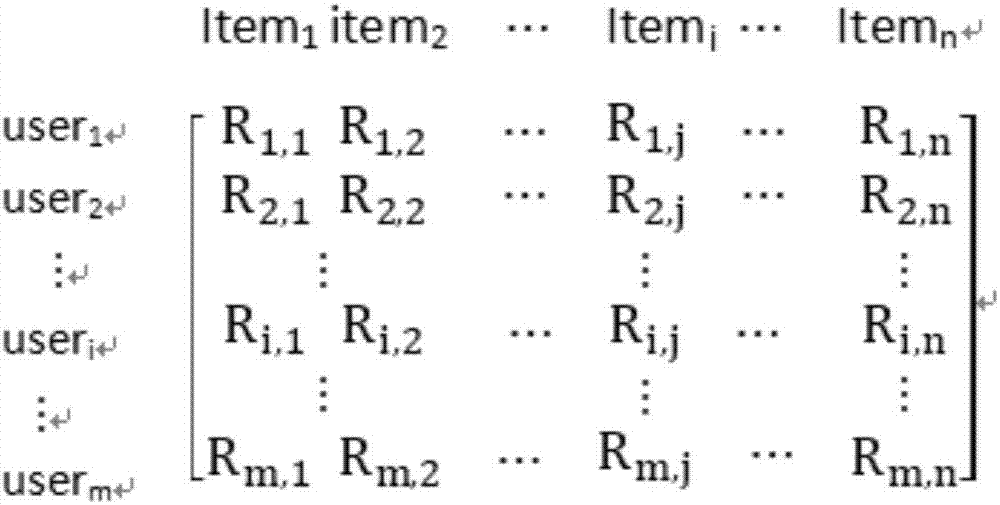Improved collaborative filtering recommendation method based on user characteristics
A collaborative filtering recommendation and user feature technology, applied in the Internet field, can solve the problems of low accuracy of information recommendation and failure to meet various needs, and achieve the effect of improving recommendation quality, small error, and accurate user similarity
- Summary
- Abstract
- Description
- Claims
- Application Information
AI Technical Summary
Problems solved by technology
Method used
Image
Examples
Embodiment 1
[0033] On the basis of the traditional user-based collaborative filtering algorithm, the embodiment of the present invention normalizes the user rating data, adopts the improved Jaccard similarity coefficient method as the user rating similarity measurement method, and adds the user rating data For the consideration of feature information, the linear combination of user attribute similarity and user rating similarity is used as the end user similarity, and then the end user similarity is used to perform neighbor calculation to generate a recommendation list, see figure 1 , the method includes the following steps:
[0034] 101: Obtain the average rating of all users, correct the original user rating range according to the average rating of all users, and use the corrected user rating interval mean and all user average ratings to correct the original user rating to obtain normalization Processed user ratings;
[0035] Through the processing of step 101 above, the average rating...
Embodiment 2
[0048] The scheme in embodiment 1 is further introduced below in conjunction with specific calculation formulas and examples, see the following description for details:
[0049] 201: Normalize the user rating data;
[0050] First traverse the historical rating records of each user to get the average rating of each user:
[0051]
[0052] Among them, R ui Indicates user u's rating on item i; n is the number of items rated by user u.
[0053] Reset the user's rating range to the following formula:
[0054]
[0055]Among them, m represents the number of all users; min(Ru1, Ru2,...,Run) represents the lowest score in user u's scoring record, max(Ru1, Ru2,...,Run) represents the highest score in user u's scoring record .
[0056] After the above processing, the average value of the user rating interval is k, and the value of k is as follows:
[0057]
[0058] The user rating after correcting the rating interval should be calculated according to the following formula: ...
Embodiment 3
[0108] Combined with the specific experimental data, Figure 2-Figure 4 The scheme in embodiment 1 and 2 is carried out feasibility verification, see the following description for details:
[0109] (1) Normalization of user ratings:
[0110] Firstly, the user evaluation matrix is generated according to the user's historical rating records, and the matrix form is as follows: figure 2 shown. Every non-zero value in the matrix is traversed and normalized to obtain a new user rating matrix.
[0111] (2) User similarity calculation:
[0112] Traverse all users in the user evaluation matrix except user u, and calculate the pairwise similarity between them and user u. The calculation process is as image 3 As shown, firstly, according to the rating records, the improved Jaccard similarity coefficient method is used to calculate the rating similarity between user u and other users, and then compare the gender, age, and occupational characteristics information of user u and o...
PUM
 Login to View More
Login to View More Abstract
Description
Claims
Application Information
 Login to View More
Login to View More - R&D
- Intellectual Property
- Life Sciences
- Materials
- Tech Scout
- Unparalleled Data Quality
- Higher Quality Content
- 60% Fewer Hallucinations
Browse by: Latest US Patents, China's latest patents, Technical Efficacy Thesaurus, Application Domain, Technology Topic, Popular Technical Reports.
© 2025 PatSnap. All rights reserved.Legal|Privacy policy|Modern Slavery Act Transparency Statement|Sitemap|About US| Contact US: help@patsnap.com



